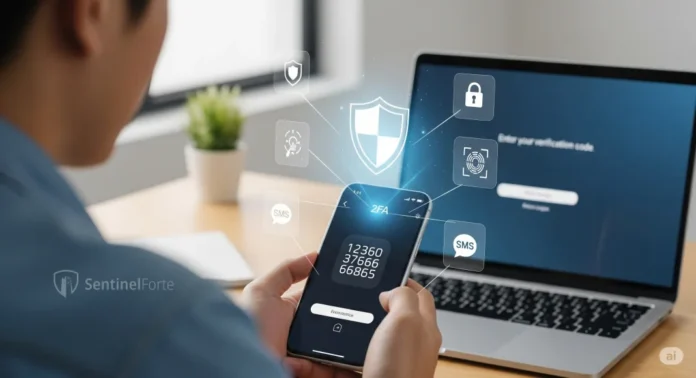Two-factor authentication (2FA) is an essential cybersecurity tool that significantly enhances account protection by requiring two separate verification methods. It prevents unauthorized access even if passwords are compromised, offering crucial defense against increasingly sophisticated cyber threats.
Imagine waking up one morning to find your email account locked, accessed by an unknown party overnight. The realization that your confidential information and digital identity might be compromised is frightening. This scenario underscores why two-factor authentication is not just recommended but vital for protecting your online presence.
According to Google’s 2024 Security Report, enabling 2FA prevents over 99% of account takeovers. With online security threats escalating yearly, understanding and implementing two-factor authentication is critical to personal and organizational security.
What Is Two-Factor Authentication?
Two-factor authentication is a security process where users provide two distinct forms of identification before accessing accounts. Typically, this involves something you know, such as a password, and something you have, like a mobile device or a biometric identifier (fingerprint or facial recognition).
This dual-layered approach makes unauthorized access significantly more difficult, safeguarding your digital accounts effectively.
Common Types of Two-Factor Authentication
Several methods of 2FA are widely used today:
- SMS Verification Codes: A one-time code is sent via SMS to your registered mobile device. Although convenient, SMS codes can sometimes be intercepted, making this method less secure compared to other forms of 2FA.
- Authentication Apps: Applications like Google Authenticator, Microsoft Authenticator, and Authy generate unique, time-sensitive codes locally on your mobile device. These codes expire quickly, greatly enhancing security compared to SMS.
- Hardware Security Tokens: Physical devices like YubiKey or RSA tokens generate codes or provide cryptographic verification. These tokens are among the most secure options, offering robust protection against phishing and remote attacks.
- Biometric Authentication: Using physical attributes like fingerprints or facial recognition for account access. Biometrics provide convenience and robust security, reducing reliance on passwords.
How to Enable Two-Factor Authentication
Enabling 2FA typically involves straightforward steps:
- Access Account Settings: Log in to the service or account you wish to secure.
- Locate Security or Privacy Settings: Find the option for two-factor or multi-factor authentication.
- Choose Preferred Method: Select SMS, authenticator app, hardware token, or biometric method.
- Follow Setup Instructions: Complete setup as guided, verifying the chosen method before activation.
Benefits of Two-Factor Authentication
Implementing 2FA significantly improves account security, providing tangible benefits:
- Enhanced Security: Dramatically reduces the risk of account breaches.
- Protection from Password Theft: Prevents unauthorized access even if passwords are compromised.
- Compliance: Meets security requirements set by various regulatory frameworks like GDPR or HIPAA.
Challenges and Considerations
Despite its advantages, there are challenges associated with 2FA:
- Accessibility Issues: Dependence on mobile devices or hardware tokens can pose challenges if devices are lost or malfunction.
- User Convenience: Some users find 2FA inconvenient due to additional steps required for account access. Selecting a method that balances convenience and security is critical.
Best Practices for Implementing 2FA
To maximize 2FA effectiveness, follow these best practices:
- Use Authentication Apps or Hardware Tokens: Prefer methods offering robust security over SMS codes.
- Backup Access Methods: Ensure backup access options are available if primary authentication methods fail.
- Regularly Update Devices and Apps: Maintain the latest versions to ensure ongoing security and functionality.
Integrating 2FA Across All Accounts
Implement 2FA across all critical accounts, including email, social media, banking, cloud services, and business platforms. Comprehensive implementation significantly reduces your overall cybersecurity risk profile.
Educating Users and Employees
Organizations should offer regular training on the importance and correct usage of 2FA. Awareness training increases adoption rates and reduces the risk of human error, ultimately enhancing organizational cybersecurity.
Future Trends in Two-Factor Authentication
As cybersecurity threats evolve, 2FA methods will continue to advance. Biometric technologies and passwordless authentication solutions are becoming more prevalent, providing seamless user experiences without compromising security.
The adoption of adaptive authentication techniques, which assess risk factors like location, device health, and behavior patterns, will further strengthen account security by dynamically adjusting security requirements based on contextual risk.
Implementing two-factor authentication is an essential step toward robust digital security. By combining something you know with something you possess or are, 2FA significantly reduces the likelihood of unauthorized access, protecting your sensitive data and digital identity.
Take control of your cybersecurity today by enabling two-factor authentication across all your important accounts, ensuring enhanced protection and peace of mind in an increasingly digital world.

